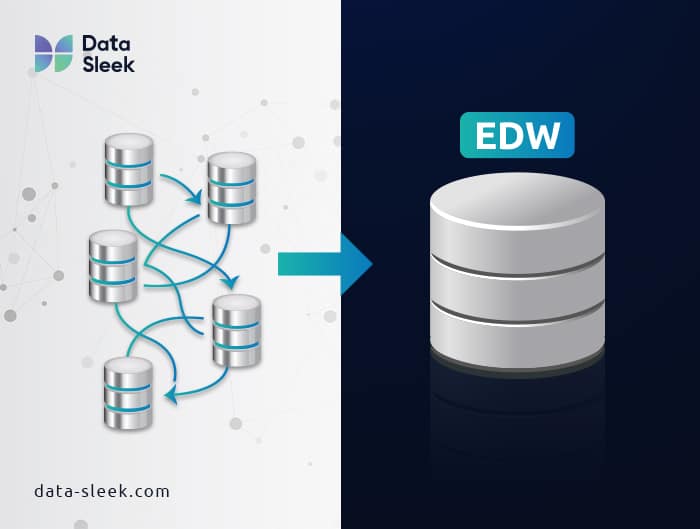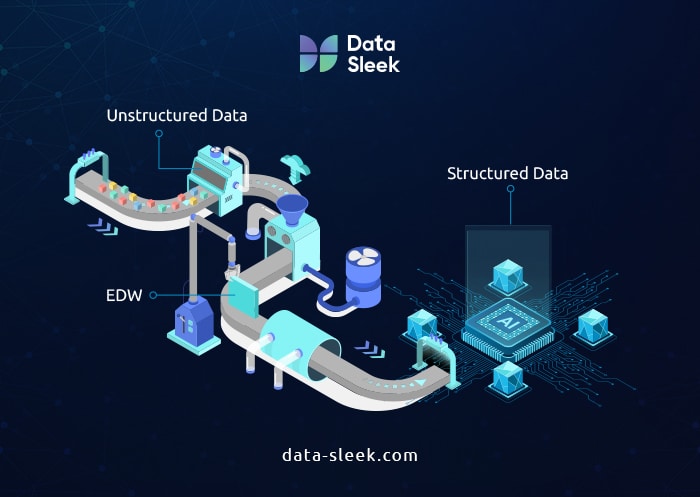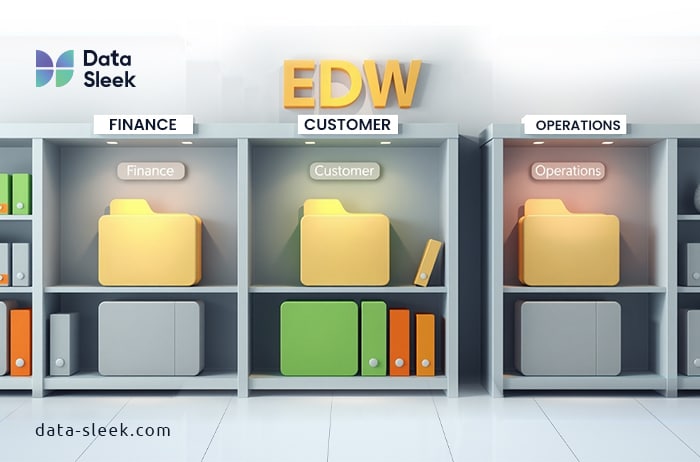Enterprise Data Warehouses (EDWs) provide vital services that can galvanize your business. A robust EDW accelerates AI adoption while also empowering data monetization strategies, which establishes a reliable single source of truth and enhances advanced analytics capabilities. This gives your organization a significant competitive edge. By modernizing your data architecture and understanding the enterprise data warehouse benefits, you can position your organization to harness next-gen technologies and stay competitive.
The Imperative for a Modern Enterprise Data Warehouse (Setting the Stage)
The New Executive Mandate: AI & Data as Core Business Drivers
Data has become a currency because it’s increasingly being valued, traded, and invested in like an asset. As such, you should ensure your business is prepared to adopt AI to extract maximum value from existing data. Failing to do so will likely result in your company losing its competitive edge. Since data is being delivered at increasingly rapid velocities and in ever-increasing volumes, it is simply too much for most individuals to handle without assistance.
Why Current Data Setups Fall Short: Recognizing the “Data Debt”
Regardless of the type of industry you are involved in, specific executive pain points exist, and one of the most significant is the inability to leverage new technologies and their benefits effectively. Some common pain points due to technology being underutilized include data siloed across several departments, insights being revealed either too late or not, and inconsistency in reports meant to serve as reliable data points. Much like having a hard drive that is badly in need of defragmentation, fragmented data leads to longer wait times, more person-hours invested, and the need to verify data across multiple silos, all of which can be rather costly.
What is an Enterprise Data Warehouse, and What is its Purpose Today?
Enterprise Data Warehouses (EDWs) are consolidated databases that enable an organization to store all its data, including both structured and semi-structured data, from various sources. This system is designed to automate business intelligence (BI) activities, allowing organizations to perform complex queries, generate reports, and conduct data analysis. Key features of a modern EDW include Cloud-Based Solutions, Data Governance and Security, Data Integration, Performance Optimization, Real-Time Data Processing, and Scalability.
Cloud-Based Solutions: Many organizations are moving toward cloud-based EDWs, which offer flexibility, reduced infrastructure costs, and easier maintenance than on-premises solutions.
Data Governance and Security: Data quality, compliance, and security are vital for EDWs. Current solutions provided by EDWs feature tools for monitoring data lineage, maintaining access control, and auditing, among other things.

Data Integration: Integrating your data creates a reliable and unified means of viewing your organization’s data, which is crucial for your enterprise’s decision-making abilities as well as its long-term strategy.
Performance Optimization: Thanks to technological advancements, modern EDWs include advanced features such as in-memory processing, columnar storage, and parallel processing. This optimization enhances query performance response times and improves the retrieval of data resources.
Real-Time Data Processing: Some EDWs offer real-time data ingestion and analysis, enabling businesses to make informed decisions based on up-to-date, accurate information.
Scalability: Modern EDWs are designed to accommodate the growing volume of data. They can scale horizontally, allowing organizations to add more resources as needed.
Unlocking AI Adoption: The EDW as Your AI-Ready Data Infrastructure
Accuracy is vital to EDWs, since inaccurate data misrepresents the real-world scenario your model is trying to anticipate. Poor-quality data leads to poor results and incorrect decisions based on flawed insights. Accurate and reliable data is necessary for successfully incorporating AI models into your business. High-quality data enhances superior machine learning processes, which ultimately increases both efficiency and reliability of AI applications and drives improved corporate goals.
The Challenge: AI’s Insatiable Need for Clean, Integrated Data
AI models are fundamentally dependent on the quality of the data used to train them. The saying “garbage in, garbage out” aptly describes this phenomenon; if the training data is flawed, inconsistent, or incorrect, the model’s predictions and outputs will almost certainly be unreliable.
Data consistency is crucial because inconsistent data can lead to confusion within the AI model. Any errors impact its ability to learn and generalize data during the training process. If related items in the training have different labels, the model will likely struggle to understand existing patterns, resulting in errors in interpretation or prediction.
Data accuracy is critical, since inaccurate data misrepresents the information you have at hand, which can lead in inaccurate reporting and costly decisions. Poor-quality data leads to lackluster results and bad choices based on skewed insights. By ensuring your data is of high quality, your business can successfully incorporate AI models. High-quality data enhances advanced machine learning, which ultimately improves the efficiency and reliability of AI applications, helping to drive improved corporate outcomes.
How EDW Delivers AI-Ready Data
Centralized Data Architecture for AI Training
A centralized data architecture is a united resource for AI-ready data infrastructure, which is essential for the effective functioning of machine learning models. Centralized data architecture facilitates data management and enhances machine learning efficiency of initiatives by providing high-quality, accessible, and diverse data in a single location. This centralization enables your business to harness the full potential of AI technologies. Having siloed data spread across multiple departments will make any AI integration both difficult and unreliable.
Handling Structured vs. Unstructured Data
Combining structured and unstructured data within your company’s EDW helps establish a data ecosystem. This data combination allows businesses to leverage advanced AI functions, which improve corporate decision-making processes and discover previously unattainable insights. By using both data types properly, your business can burnish its advanced analytics capabilities and drive innovation.

Data Governance Framework: The Bedrock of Trustworthy AI
A robust data governance framework within an EDW not only improves data quality but also helps ensure compliance with regulatory bodies. It also lays the groundwork for the ethical use of AI within your organization. Creating standards, monitoring practices, and encouraging collaboration are critical tools that governance organizations use to manage data effectively while maintaining best practices. Areas that such a framework will enhance include Compliance, Data Quality, and Ethical AI Usage, which will significantly improve your business data quality.
Data Monetization Strategies: Transforming Data into Profit Centers
From Raw Data to Revenue Streams: The EDW’s Role
EDWs let companies leverage their data to create additional revenue streams. Organizations unlock insights that drive better decision-making, enhance customer experiences, and ultimately create new data monetization strategies by efficiently aggregating, transforming, and improving data. Examples include optimizing your pricing models, powering the development of new data products, and supporting data monetization strategies such as offering embedded analytics, usage-based pricing models, or anonymized trend insights to partners or customers, where regulation allows.
Driving Advanced Analytics Capabilities and Predictive Insights
Enterprise Data Warehouses (EDWs) are designed to enable advanced analytics and generate predictive forecasts utilizing business data. Consolidating data from several sources empowers the EDW to create a comprehensive data repository, allowing your business to analyze both historical and real-time data effectively.
Data centralization uses data modeling and analysis to compile complex data and provide your business with actionable results. Said insights include the discovery of opportunities, identifying trends, and enhancing customer knowledge. Having accurate and unified data allows your business to make informed decisions, including predicting business trends and designing strategies to meet ever-shifting demands.
Fueling AI-Powered Business Intelligence
AI data-driven insights enable your company to improve in key areas, like enhanced customer engagement, maintaining your competitive edge, and optimizing future operations.
Real-Time Accessibility for Agile Monetization
Compiling and centralizing all company data lets EDWs create accurate reports that can be viewed by employees, executives, and stakeholders as needed. Centralizing your data allows for rapid analysis and decision-making, which is imperative. This is especially true when identifying competitive threats and emerging trends, to analyze customer preferences, and to adjust strategies proactively. Real-time access helps teams quickly develop data products. It allows for faster design changes, A/B testing, and immediate feedback, making the processes faster. This increase in speed improves the relevance of products, and ensures your company offers products and services meeting or exceeding current consumer needs.

Strategic Enterprise Data Warehouse Benefits: Beyond Technology
Centralized Data Architecture for Business Alignment
Centralizing your organization’s data significantly reduces the amount of siloed data, enabling a comprehensive and accurate analysis. It also permits continuous monitoring of relevant Key Performance Indicators (KPIs) and provides visibility across your entire enterprise.
Real-Time Data Accessibility for Faster Decisions
Before advancements in real-time data accessibility, businesses were forced to rely on delayed reporting, significantly hindering data monitoring and all that it entails. By embracing the shift from archaic methods and unnecessary delays to real-time AI-powered dashboards, the impact on decision-making for operations continues to have profound implications for C-Suite executives and their planning.
AI-Ready Data Infrastructure
Organizing your data neatly and orderly is crucial for advanced technologies, including deep machine learning and generative AI. It is also vital if your business plans to utilize any business intelligence tools powered by AI, a rapidly expanding technology field that shows no signs of slowing down.
Single Source of Truth in Data
Much like how a library serves as a trusted repository of knowledge, which is neatly divided by subject and title, having a singular data source is imperative for any EDW. If the EDW is meant to serve as the one hub for trusted data across your organization, having a single source of truth is crucial. Having your data neatly arranged in a single location will have several positive impacts, including preventing rework, avoiding miscommunication, and lowering the number of errors encountered.
Advanced Analytics and Predictive Insights
EDWs significantly enhance forecasting, pattern detection, and scenario planning in several ways:
- Facilitating Enhanced Forecasting
- Pattern Detection and Scenario Planning by Providing Real-Time Insights
- Leveraging Historical Data
- Detecting Anomalies
- Allowing for Scenario Simulations
- Integrating With Advanced Analytics and Enabling Dynamic Adjustments
Executives should also note that such technology can also alleviate supply chain use cases, including improved forecasting for product demand, enhancing your company’s inventory and logistics divisions, optimizing risk management, and developing detailed analytics based on customer behavior.
Enterprise-Level Integration
Unified data from different sources enables EDWs to enhance decision-making by making operations more efficient, and providing a top-down, holistic view of your business performance. By combining APIs with automation, businesses can create efficient and reliable data pipelines, increase data management and data-driven decision making. EDWs unify data from various sources such as CRM, ERP, IoT devices, and SaaS tools through several key strategies:
- Improved Data Integration
- A Centralized Data Repository
- Data Processing in Real-Time
- Cleaning and Harmonizing Data
- Integrating Advanced Analytics
- Connectors and APIs
- Scalable Architecture
Data Consistency, Accuracy, and Governance
Data governance frameworks are vital for ensuring efficient data management and maintaining any data compliance. EDWs enable these frameworks to exist, creating a single location for data management and storage and providing accurate data-driven decision making. Enhanced by EDWs, these frameworks allow businesses to logically manage data while ensuring compliance, quality, and security.
Monetizing Data Assets at Scale
Leveraging clean and accessible data effectively empowers organizations to engage their customers more meaningfully, innovate their product offerings, and build partnerships that drive new revenue opportunities. Key revenue-generating strategies include easy integration with APIs to create new income streams, identifying market gaps and developing trends, and utilizing customer segmentation to derive insights from data-driven decision making, thereby improving engagement and optimizing advertising.

Scalability and Cost Efficiency
Considering long-term costs, cloud-native EDWs are better for reducing upfront expenditure by offering flexible pricing models. Cloud-native solutions offer better elasticity when considering scale, allowing businesses to adapt easily to changing needs without physical infrastructure limitations. Modular architecture provides a robust foundation for growth by enhancing scalability, flexibility, and efficiency while minimizing risks and costs associated with system expansions.
Need help designing or modernizing your setup to enjoy enterprise data warehouse benefits? Explore our data warehouse consulting services.
Implementing Your Strategic EDW: Best Practices for Executive Success
By partnering with an experienced firm like Data-Sleek, your business can enjoy enterprise data warehouse benefits with expert guidance on executing plans for an EDW, walk you through the implementation step-by-step, and reassure any skeptical executives.
Key Enterprise Data Warehouse Best Practices
Incorporating EDWs requires a proper focus on the phased implementation of the new system, securing executive sponsorships, conducting strategic planning, and selecting the best technology companies to partner with.
The Role of Data Architecture and Management Consulting
By retaining consulting expertise, your company’s EDW will align with your business goals and help drive future growth.
FAQs
Is your enterprise data ready for AI?:
There are several factors, including data quality, accessibility, having the necessary tools and technology, executive and shareholder support, and having employees with the right skills.
How does an enterprise data warehouse enhance AI model accuracy and reliability?
An enterprise data warehouse enhances the accuracy and reliability of AI models by ensuring data quality, providing a comprehensive view of integrated datasets, enabling historical analysis, and supporting data governance frameworks and advanced analytics.
What role does a data warehouse play in enabling real-time AI-driven insights?
A data warehouse serves as the backbone for real-time AI-driven insights by providing a reliable, organized, and an accessible source of data architecture that enables efficient processing and analysis.
How can an EDW improve data governance for trustworthy AI decision-making?
Implementing the components mentioned previously allow EDWs to support data governance and enhance the overall integrity and trust in AI decision-making processes.
Why is scalable architecture in a data warehouse crucial for advanced AI workloads?
Scalable data warehouse architecture permits organizations to manage large and complex AI workloads efficiently, adapt to changing demands, and maintain performance and cost-effectiveness, all of which are critical for leveraging AI effectively.
How does integrating AI capabilities in a data warehouse streamline advanced analytics capabilities and innovation?
Leveraging AI capabilities within a data warehouse lets organizations create a more agile, data-driven culture that promotes advanced analytics capabilities and innovation, ultimately leading to enhanced business performance.



